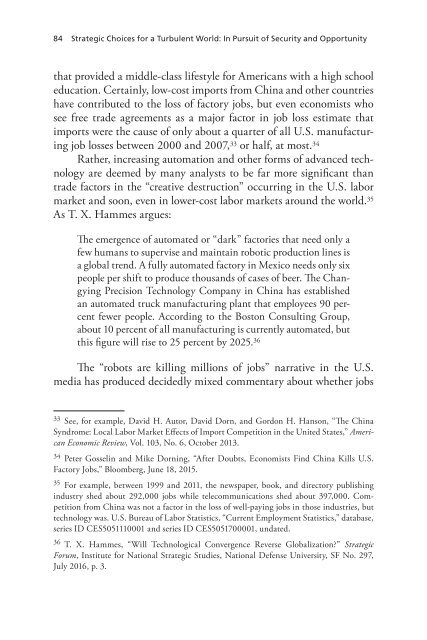You also want an ePaper? Increase the reach of your titles
YUMPU automatically turns print PDFs into web optimized ePapers that Google loves.
84 Strategic Choices for a Turbulent World: In Pursuit of Security and Opportunity<br />
that provided a middle-class lifestyle for Americans with a high school<br />
education. Certainly, low-cost imports from China and other countries<br />
have contributed to the loss of factory jobs, but even economists who<br />
see free trade agreements as a major factor in job loss estimate that<br />
imports were the cause of only about a quarter of all U.S. manufacturing<br />
job losses between 2000 and 2007, 33 or half, at most. 34<br />
Rather, increasing automation and other forms of advanced technology<br />
are deemed by many analysts to be far more significant than<br />
trade factors in the “creative destruction” occurring in the U.S. labor<br />
market and soon, even in lower-cost labor markets around the world. 35<br />
As T. X. Hammes argues:<br />
The emergence of automated or “dark” factories that need only a<br />
few humans to supervise and maintain robotic production lines is<br />
a global trend. A fully automated factory in Mexico needs only six<br />
people per shift to produce thousands of cases of beer. The Changying<br />
Precision Technology Company in China has established<br />
an automated truck manufacturing plant that employees 90 percent<br />
fewer people. According to the Boston Consulting Group,<br />
about 10 percent of all manufacturing is currently automated, but<br />
this figure will rise to 25 percent by 2025. 36<br />
The “robots are killing millions of jobs” narrative in the U.S.<br />
media has produced decidedly mixed commentary about whether jobs<br />
33 See, for example, David H. Autor, David Dorn, and Gordon H. Hanson, “The China<br />
Syndrome: Local Labor Market Effects of Import Competition in the United States,” American<br />
Economic Review, Vol. 103, No. 6, October 2013.<br />
34 Peter Gosselin and Mike Dorning, “After Doubts, Economists Find China Kills U.S.<br />
Factory Jobs,” Bloomberg, June 18, 2015.<br />
35 For example, between 1999 and 2011, the newspaper, book, and directory publishing<br />
industry shed about 292,000 jobs while telecommunications shed about 397,000. Competition<br />
from China was not a factor in the loss of well-paying jobs in those industries, but<br />
technology was. U.S. Bureau of Labor Statistics, “Current Employment Statistics,” database,<br />
series ID CES5051110001 and series ID CES5051700001, undated.<br />
36 T. X. Hammes, “Will Technological Convergence Reverse Globalization?” Strategic<br />
Forum, Institute for National Strategic Studies, National Defense University, SF No. 297,<br />
July 2016, p. 3.




